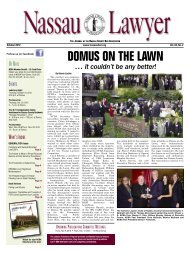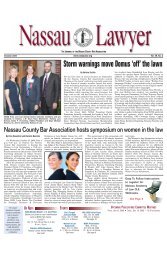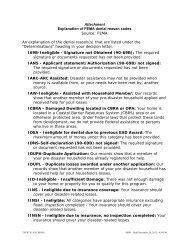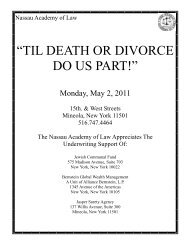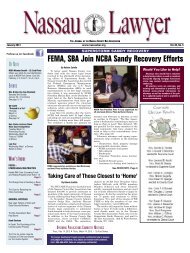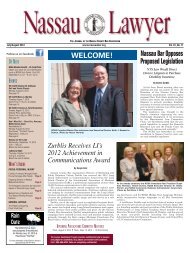FRAUDULENT CONVEYANCES Nassau Academy of Law CLE Live ...
FRAUDULENT CONVEYANCES Nassau Academy of Law CLE Live ...
FRAUDULENT CONVEYANCES Nassau Academy of Law CLE Live ...
Create successful ePaper yourself
Turn your PDF publications into a flip-book with our unique Google optimized e-Paper software.
The terms <strong>of</strong> Section 548 are virtually identical with the provisions<strong>of</strong> the Uniform Fraudulent Conveyance Act, adopted by most states, includingNew York 1 . A transfer is “fraudulent,” and thus may be voided, if (a) it was madewith actual intent to hinder, defraud or delay creditors, or (b) the transfer wasmade while the debtor was insolvent or left insolvent by the transfer and the debtorreceived less than a reasonably equivalent value in return for the transfer.The main differences between bringing an action under the Code, asopposed to State <strong>Law</strong>, is that under the Code: a) there is a 2 year reach backperiod, as opposed to the 6 yr State provision; b) State law generally requires thatthere be an actual creditor identified that existed at time <strong>of</strong> Transfer and createsdefenses that might have existed against that creditor whereas in Bankruptcy thetrustee sues in his own right; c) the State law generally has more stringent standard<strong>of</strong> pro<strong>of</strong> and d) Section 548(a)(1)(b)(ii)(IV) allows the avoidance <strong>of</strong> a transfer toor for benefit <strong>of</strong> Insider under an employment contract and not in the ordinarycourse <strong>of</strong> business(i.e., <strong>of</strong>fensive bonuses and golden parachutes.Assumed Agreement: In re Network Access Solutions Corp. 330 B.R. 67(Bankr. Del. 2005). Creditor’s Committee sought to avoid and recover largepayments made to 2 <strong>of</strong>ficers prior to Chapter 11 under their employmentagreement. However, earlier in the case the Debtor had successfully moved toassume the <strong>of</strong>ficers employment agreements. The Court found it would beantithetical for the court to have ruled the assumption was in the best interest <strong>of</strong>the debtor and then rule that the agreement presented a bad faith arrangement thatdid not give reasonably equivalent value. Moreover the Court held the Committeewas judicially esptopped from asserting the avoidance action since it supported theassumption and was assumed to have reaped the benefits <strong>of</strong> same.In bankruptcy the trustee has two years to bring action even if 6 yr statute expires as longas 6 yr statute did not run before date <strong>of</strong> petition.Statute <strong>of</strong> Limitations ran on property transfer from date <strong>of</strong> recording <strong>of</strong> new deed.Ehrler v. Cataffo (2 dept 2007) 42 A.D. 3d 424Section 548(a)(2) also excepts charitable contributions from avoidance ifnot more that 15% <strong>of</strong> gross annual income, or if it exceeds that amount wasconsistent with the Debtor’s past practices. (Religious or charitable entity ororganization is defined by reference to the Internal Revenue Code)1 Article 10 <strong>of</strong> the New York Debtor and Creditor <strong>Law</strong>.



